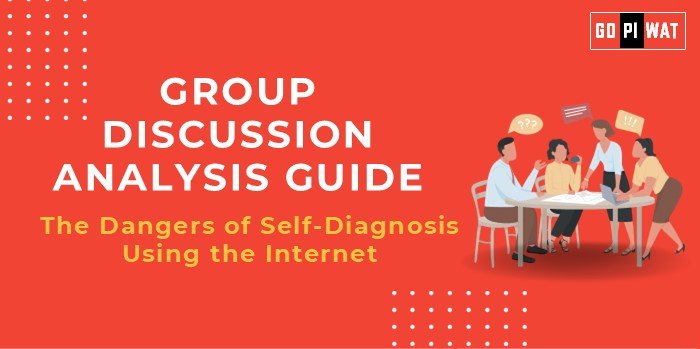📋 Group Discussion (GD) Analysis Guide: The Dangers of Self-Diagnosis Using the Internet
🌐 Introduction to The Dangers of Self-Diagnosis Using the Internet
Opening Context: With over 5 billion internet users globally, the ease of access to online medical information has transformed how people approach healthcare. However, this convenience comes with risks of misinformation and inappropriate self-treatment.
Topic Background: Self-diagnosis using the internet emerged as digital health platforms proliferated. While it offers preliminary health insights, it has led to issues like anxiety, incorrect diagnoses, and delayed professional consultations. Recent studies highlight the gap between credible medical advice and the accessibility of trustworthy sources online.
📊 Quick Facts and Key Statistics
❌ Misinformation Rate: Up to 60% of health-related search results can be misleading (Journal of Medical Internet Research, 2023).
😟 Medical Anxiety Spike: 35% of frequent self-diagnosers report health anxiety (WHO, 2022).
🕒 Doctor Consultations Delayed: 1 in 3 individuals delay seeking medical attention after online self-diagnosis.
🤝 Stakeholders and Their Roles
- 🏥 Healthcare Professionals: Advocating for professional diagnoses and raising awareness about risks.
- 💻 Tech Companies: Developing AI-driven reliable health platforms and combating misinformation.
- 🏛️ Governments: Regulating online health content and ensuring accessibility to healthcare services.
- 👩⚕️ Patients: Balancing online research with professional medical advice.
🏆 Achievements and Challenges
✨ Achievements:
- 📈 Increased health awareness: among the public.
- 🤖 AI-based tools: Development of AI-based tools offering preliminary guidance (e.g., symptom checkers).
- 🌐 Healthcare access: Enhanced healthcare access in underserved areas through telemedicine.
⚠️ Challenges:
- 🔗 Unverified content: Proliferation of unverified content on non-medical platforms.
- ❗ Over-reliance: Self-diagnosis leading to untreated serious conditions.
- 😟 Health anxiety: Rising health anxiety and psychosomatic conditions.
🌍 Global Comparisons:
- 🇺🇸 USA: Robust regulation of online health information through partnerships with credible medical institutions.
- 🇩🇪 Germany: Strict guidelines for digital health platforms under GDPR compliance.
📚 Case Study:
🇮🇳 India: Initiatives like Aarogya Setu provide accurate health updates; however, urban-rural disparities persist in internet literacy.
🗣️ Structured Arguments for Discussion
Supporting Stance: “Self-diagnosis empowers individuals to take charge of their health, particularly in underserved areas.”
Opposing Stance: “Self-diagnosis often leads to mismanagement of health conditions, risking life-threatening delays.”
Balanced Perspective: “While online tools aid health awareness, professional guidance is irreplaceable for accurate diagnosis.”
💡 Effective Discussion Approaches
- 📊 Opening Approaches:
- Statistic: “Did you know 60% of online health information is misleading?”
- Question: “Can self-diagnosis truly replace professional medical advice?”
- Case Example: “In 2023, a viral health trend led to widespread misuse of antibiotics in the US.”
- 🛠️ Counter-Argument Handling: Highlight statistics: “While self-diagnosis aids awareness, its error rate is alarmingly high.” Use expert opinions: “According to the WHO, accurate diagnosis demands trained professionals, not algorithms.”
📈 Strategic Analysis of Strengths and Weaknesses
- 🏅 Strengths: Accessibility, Preliminary Awareness, Symptom Checkers.
- ⚠️ Weaknesses: Misinformation, Health Anxiety, Reduced Professional Consultations.
- 💡 Opportunities: AI-driven credible platforms, Health literacy campaigns.
- ⚡ Threats: Cybersecurity risks, Legal liabilities, Spread of pseudoscience.
🎓 Connecting with B-School Applications
- 📚 Real-World Applications: Healthcare management, Risk analysis in digital health startups.
- 💬 Sample Interview Questions:
- “How can tech companies combat health misinformation?”
- “What role does healthcare literacy play in mitigating self-diagnosis risks?”
- 🔑 Insights for B-School Students: Explore healthcare regulations, AI in healthcare, and behavioral studies on digital health trends.


